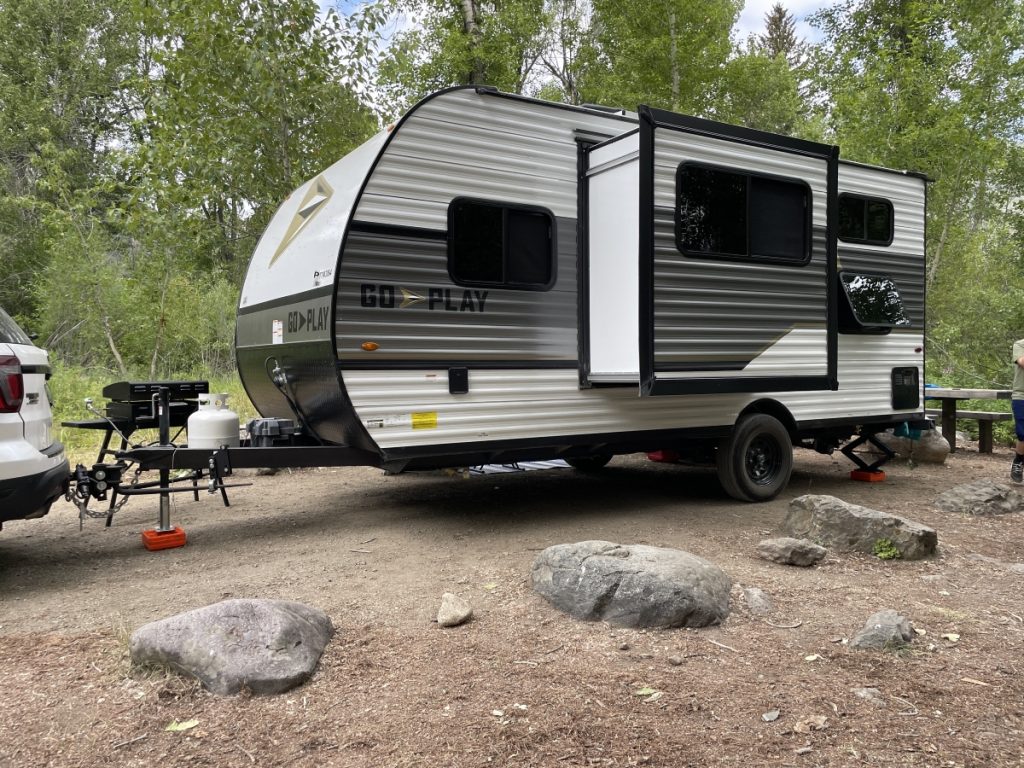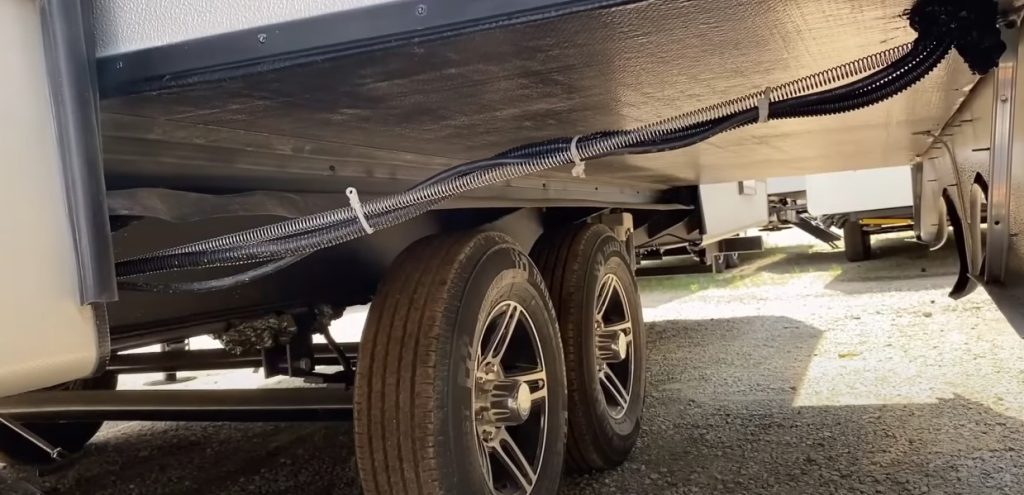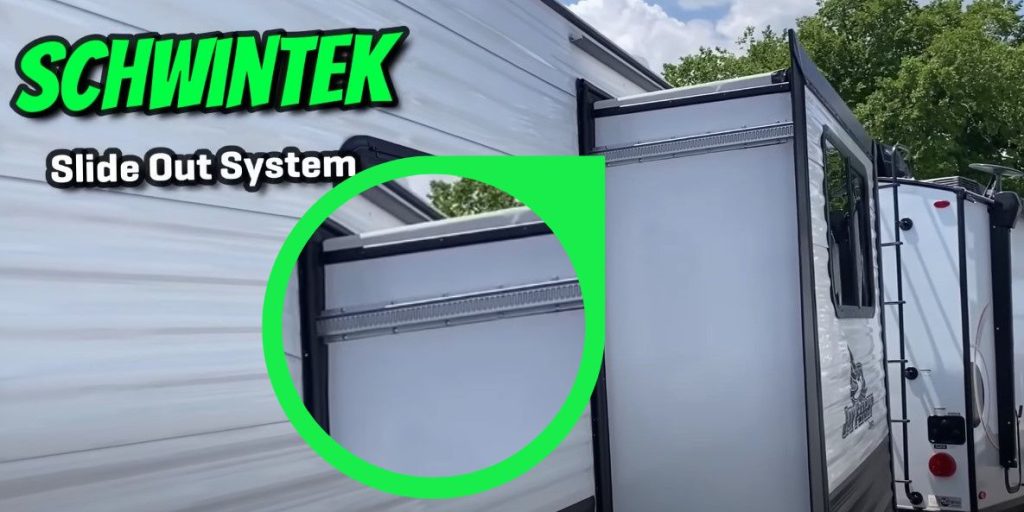The RV slide-out, they’ve been around for over 100 years and one thing is for sure, the desire for extra square footage is just as important today as it was back then! But the slide-out has come a long way since the beginning and the evolution of these expandable sections is a hot topic in the RV community. Whether you are a first-time RV goer or a seasoned road explorer looking to expand your traveling floor plan, you’re probably wondering, “What slide is best?” Don’t worry! We are here to walk you through the different types of towable slides so you can decide what slide will create the ultimate space that you will enjoy year after year!

Table of Contents
The Rack and Pinion Slide
When it comes to RV slide systems, the rack and pinion mechanism stands out as one of the oldest and most widely used designs. Also known as a “through frame” slide, this system offers a unique set of advantages and challenges for RV manufacturers and owners alike. Let’s break down the details of one of the ‘OG’s’ of the RV slide phenomenon.
How It Works
The rack and pinion slide system is characterized by a large ram bar attached to the slide-out. This bar passes through a hole (yes, a hole) in the RV’s chassis frame rail, with the push-pull mechanism located beneath the floor. This design is both its greatest asset and its most significant liability.
Pros of Rack and Pinion Slides
Floor-Flush Design: The rack and pinion system allows for a more flush transition between the main floor and the slide-out area, eliminating the dreaded “toe-stubber” step often found in other designs.
Natural Water Runoff: Because of the slight downward angle of the extended slide’s roof, it provides natural water runoff, reducing the risk of water pooling, potential leaks, and possible ice damming during freeze-thaw cycles, which is a common issue in flat-roofed slide systems.
Manual Override: The manual override in a rack and pinion slide system is a crucial backup method to extend or retract the slide-out room if the electric motor fails. This allows you to still operate the slide-out manually in case of power loss or motor malfunction, preventing the room from being stuck in an extended or retracted position. The manual override makes the rack and pinion slide a winner in reliability and ease!
Cons of Rack and Pinion Slide
Space Constraints: Because the mechanism takes up valuable space in the RV’s underbelly, it limits room for holding tanks, especially in smaller trailers – this may be a dealbreaker for the larger traveling crews.
Chassis Modifications: Due to the need for a reinforced chassis to accommodate the through-frame design, RVs with rack and pinion slides often weigh more. A heavier-duty RV typically means more cost.
From the Outside: The rack and pinion slide might appear slightly “wonky” due to the downward angle when extended. But don’t let the look take away from the benefit of having a natural water runoff!
The rack and pinion slide system, despite its few challenges, remains a popular choice in RV design due to its simplified and straightforward mechanism. And you can’t go wrong with the ‘seamless’ living space while providing inherent water management benefits.
Cable Slide
Engineering that stands in stark contrast to its rack and pinion predecessor, the cable slide is situated above the floor line making this a less obtrusive design that doesn’t puncture the barrier of the chassis frame rail or underbelly. The advantages and disadvantages of the cable slide may surprise you, but that’s why we are here!
How it Works

The cable slide is a mechanism that uses cables, pulleys, and an electric motor to extend and retract. Known for its lightweight construction while still being able to manage slide outs that are both longer and heavier than average – the cable slide might be the perfect slide for you!
Pros of Cable Slides
Exists completely above the floor line: This design leaves more space in the underbelly of the RV, allowing for other components or features to be installed there. Who doesn’t love having extra square footage in the RV and extra storage below the RV?!
Lighter than rack and pinion systems: The reduced weight can improve fuel efficiency and increase the available cargo capacity of the RV.
Mechanism is more protected from weather: Being inside the RV, the system is less exposed to elements like rain, snow, and road debris, potentially increasing its lifespan.
Cons of Cable Slides
The slide face tends to stick into the RV slightly: This can marginally reduce interior space when the slide is retracted.
Cable Stretches Over Time: The cable stretching over time may cause slack which can affect the slide’s operation and may require servicing to maintain optimal performance.
Historical Issues: As you consider the different types of slides, you are probably wondering, “Are RV sides reliable?” In early models and during 2015-2016, there were significant problems with cable slides. Although it’s a less common problem today, it’s still important to keep this in mind when you are shopping for a cable slide.
Schwintek Slide

These innovative slide-out mechanisms have become increasingly popular in the RV world in terms of weight savings and space efficiency. For those prioritizing fuel economy and a smaller RV, the Schwintek slide may be an excellent choice! But just like any technology, they come with their own set of advantages and disadvantages.
How it Works
Unlike traditional systems that use ram bars or cables, the Schwintek system employs distinctive silver, worm-like gears typically positioned on the top and bottom of the slide-out. These gears are the key components that facilitate the extension and retraction of the slide-out.
Pros of Schwintek Slide
Space-Saving Design: Schwintek slides are known for their slim profile, which means they take up less space in your RV’s walls. This can translate to more interior living space when the slides are retracted.
Lightweight: Compared to hydraulic slides, Schwintek slides are significantly lighter. This can improve your RV’s fuel efficiency and increase your overall payload capacity.
Easy Operation: These slides are typically operated by a simple push-button system, making them user-friendly for RVers of all experience levels. Schwintek slides offer a smooth and quiet operation, enhancing the overall RV experience.
Cons of Schwintek Slide
Potential for Misalignment: One of the most common complaints about Schwintek slides is their tendency to become misaligned over time. This can lead to sealing issues and potential water leaks.
Power Dependency: Schwintek slides rely entirely on electric power. If your RV’s battery dies or there’s an electrical issue, you might find yourself unable to extend or retract the slide.
Complexity of Repair: When issues do arise, Schwintek slides can be more complex to repair than traditional hydraulic systems. This might mean more downtime and potentially higher repair costs.
The Schwintek slide system offers significant advantages in terms of weight savings and space efficiency, making it an excellent choice for smaller RVs and those prioritizing fuel economy.
* Check out Bish’s slide out maintenance guide to better understand how to maintain your slide-out system.
Happy Jack Slide
While not as common as it once was, the Happy Jack slide system still plays a crucial role in specific RV applications. This system shares similarities with the Schwintek slide but has its own unique characteristics.
Key features of the Happy Jack slide system:
- Typically used for shallow slide-outs that don’t block the RV when closed
- Located above the floor and wheel well
- Lacks silver worm gears and cables seen in other systems
- Often features a self-contained control button within the slide box instead of on the main control panel
While not extinct, the Happy Jack slide system is less common in modern RVs. However, its unique design and self-contained nature make it a noteworthy feature for the RV enthusiast.
RV slide mechanisms have come a long way – with rack and pinion, cable, and Schwintek systems each offering unique advantages.
To recap, rack and pinion slides provide robust support and smooth operation, ideal for larger slideouts. Cable systems offer a lightweight alternative with a simpler design, perfect for smaller RVs or those looking to reduce weight and increase underbelly capacity. The innovative Schwintek mechanism brings a space-saving solution with its in-wall design, appealing to those who prioritize interior space and streamlined aesthetics.
When choosing an RV, consider how these different slide mechanisms align with your needs in terms of reliability, maintenance, and overall camping experience.
The best way to determine what slide would work best for you is to experience it for yourself! Feel free to reach out to one of our RV experts who can demonstrate the different slide options!
Whichever system you opt for, modern slide mechanisms have made RV living more comfortable and convenient than ever before!

Brooke Erickson
Some say I am a writer…I like to say I am a storyteller.
